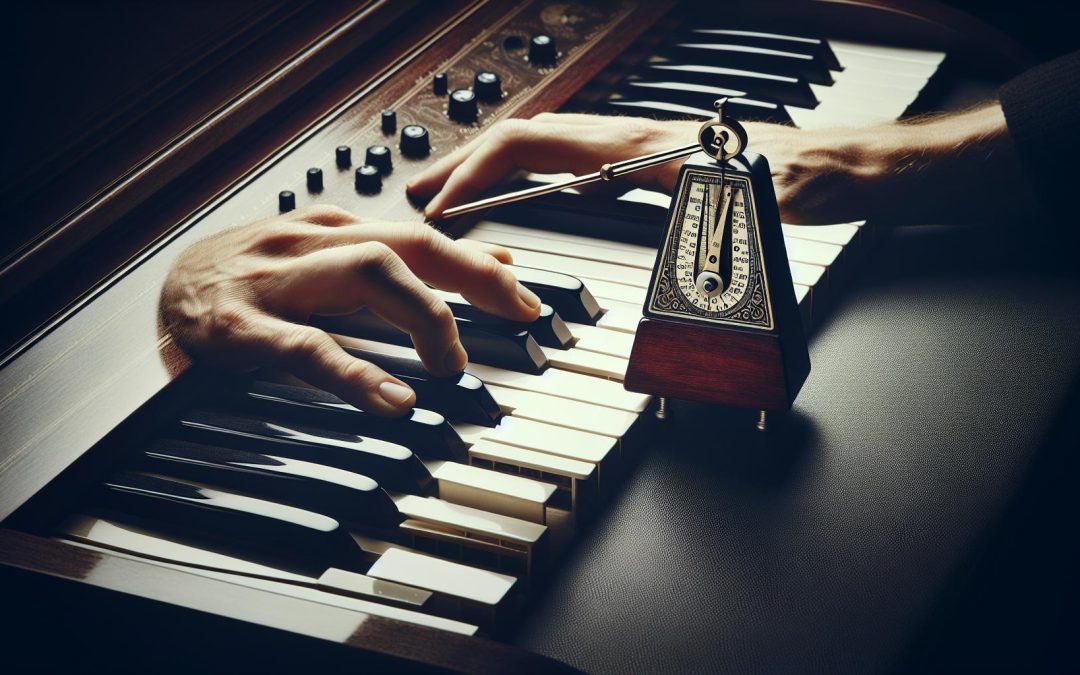Diving into the world of music can be thrilling, and there's no better way to start than by learning to play chords on a keyboard. It's the foundation of countless songs and a skill that opens up a universe of musical possibilities. Whether you're dreaming of composing your own melodies or simply want to jam along to your favorite tunes, mastering chords is your first step on this exciting journey.
For beginners, the keyboard might seem a bit intimidating with its sea of black and white keys. But don't worry, they'll soon become your best friends. With a bit of patience and practice, you'll be playing chords like a pro in no time. So, let's get those fingers ready to dance across the keys and discover the magic of making music.
Understanding Chords
In the journey of mastering the keyboard, understanding chords is akin to unlocking a treasure trove of musical possibilities. Chords form the backbone of most music, providing the harmonic foundation on which melodies dance. They're not just groups of notes played together but are the emotional language of music, capable of conveying joy, sorrow, tension, and resolution.
For beginners, the world of chords might seem vast and intricate, but at its heart, chords are built on simple, fundamental principles. A chord, in its most basic form, is a combination of three or more notes played simultaneously. These basic chords form the stepping stones for more complex harmonies and are essential for anyone looking to play music on a keyboard.
Major and Minor Chords
At the center of chord learning are the major and minor chords, the yin and yang of the music world. Major chords are bright, happy, and straightforward, creating a sound that's full of optimism. In contrast, minor chords are deeper, often evoking a sense of melancholy or introspection. The difference between them lies in the middle note of the chord, which is shifted down by a half step in minor chords, altering the chord's entire mood and color.
Chord Progressions
Once familiar with individual chords, the next step is understanding how they connect to form chord progressions. These progressions are sequences of chords that move the song from one emotional state to another, providing the narrative flow that guides listeners on a musical journey. Some chord progressions have become staples in music due to their pleasing resolution and memorable sound.
Practice Makes Perfect
For beginners, practicing chord shapes and transitions is crucial. Starting with simple chords and progressing to more complex combinations can help in gradually building muscle memory. A handy practice technique is to pick a chord progression and practice switching between chords smoothly, focusing on the movement of fingers from one position to another.
| Activity | Recommendation |
|---|---|
| Chord Practice | Start with C, G, Am, F sequence. |
| Finger Placement | Use one finger per note, ensuring comfortable movement. |
| Transition Speed | Begin slowly, aiming for accuracy over speed. |
Getting Familiar with Keyboard Layout

Before diving deep into the world of chords, it's crucial for beginners to get comfortable with the keyboard layout. This familiarity lays the groundwork for easier chord playing and overall musical exploration. The keyboard comprises white and black keys, each corresponding to different musical notes.
The white keys represent the notes A, B, C, D, E, F, and G, which then repeat across the keyboard. Starting from middle C, these notes are the foundation of basic music theory and understanding them is the first step in learning how to play chords. The black keys, placed between some of the white keys, are used to play sharp (#) and flat (b) notes which modify the pitch of the white keys slightly up or down, respectively.
Recognizing the repeating pattern of the keyboard is something beginners should practice. A good starting point is to locate middle C, which is usually found near the center of the keyboard. It acts as a reference point for identifying all other notes. A helpful tip is to notice the pattern of the black keys - they're grouped in twos and threes across the keyboard. Middle C is directly to the left of the first black key in the group of two.
To aid in learning, many beginners find it helpful to label the keys with their corresponding notes. This can be done using small stickers or erasable markers. However, it's important not to become too reliant on these labels, as the goal is to eventually recognize the notes instinctively.
Basic Keyboard Functions
Besides the layout of the keys, beginners should also familiarize themselves with the basic functions of the keyboard. Most keyboards come with various settings and features that can enhance learning. Volume control, for instance, allows players to practice at a comfortable sound level. Understanding how to use the metronome feature can aid in keeping time, an essential skill when playing music.
Some keyboards also feature built-in learning programs, which can guide beginners through basic lessons and song practice. Experimenting with different instrument sounds can also make practice sessions more enjoyable and offer a feel of playing with other instruments.
Practicing Note Recognition
Regular practice in recognizing notes is crucial. Beginners might start by playing each note from A to G in order and then trying to play them randomly to test their recall. Listening to the sound each note makes and associating it with its position on the keyboard helps in developing an ear for music, an invaluable skill for any musician.
Basic Music Theory

Before diving into the mechanics of playing chords, beginners should grasp some fundamental music theory. This knowledge not only aids in understanding how chords are constructed but also enhances overall musical intuition.
At the heart of music theory lies the concept of scales, a sequence of notes in a specific order. The most common scale, and perhaps the most important for beginners, is the C Major Scale. This scale is unique because it consists entirely of white keys on the keyboard, making it an excellent starting point for learning. The notes in the C Major Scale are C, D, E, F, G, A, B, and then back to C, creating a do-re-mi-fa-so-la-ti-do pattern. Understanding this scale is crucial as it provides the foundation for forming chords.
Chords are essentially a group of notes played together to produce a harmonious sound. The simplest type of chord is the triad, which consists of three notes. To form a triad, one would start with a root note, add the third note above the root, and then add the fifth note above the root. For example, a C Major chord is formed by playing C (the root), E (the third), and G (the fifth) together. This brings us to an essential point in music theory: intervals. Intervals refer to the distance between two notes. In the context of a C Major chord, E is a major third interval from C, and G is a perfect fifth interval from C.
Beyond major chords, there are minor chords, which have a slightly different construction and offer a different mood or feel in music. A minor chord is formed by lowering the third note by one semitone. Taking the A Minor chord as an example, the notes would be A (the root), C (the minor third), and E (the fifth). This minor adjustment changes the chord's emotional tone, illustrating how slight variations in intervals can significantly affect a chord's sound.
Playing Major and Minor Chords

After grasping the basics of music theory and understanding how chords are formed, beginners are now ready to move on to the practical aspect of playing chords on a keyboard. One of the first steps is learning to play major and minor chords, which are pivotal in music, imparting different emotional textures to a piece.
To start, let’s focus on major chords, known for their bright and happy sound. A major chord is formed by combining the root note, a major third, and a fifth. For instance, to play a C Major chord, one would need to press C (the root), E (a major third above C), and G (a fifth above C) simultaneously. Beginners should practice finding these intervals on the keyboard, starting with the C Major chord, as it solely involves white keys, making it less intimidating.
Moving on to minor chords, which convey a more melancholic or somber tone, the only difference between a major and minor chord is the third interval. In a minor chord, the third is a minor third from the root, not a major third. To convert the previously learned C Major chord into a C Minor chord, simply lower the E to an E flat. This minor adjustment drastically changes the chord's mood, showcasing the power of intervals in music.
Here’s a simple breakdown of the notes in C Major and C Minor chords:
| Chord Type | Notes |
|---|---|
| C Major | C, E, G |
| C Minor | C, E♭, G |
To facilitate learning, beginners should practice these chords in a rhythmical pattern, playing each chord four times before switching to another chord. This not only helps in memorizing the placement of notes but also in developing a sense of rhythm, which is crucial in music.
Additionally, incorporating chord inversions into practice sessions can significantly improve fluency on the keyboard. An inversion involves rearranging the notes of a chord so that a different note becomes the base. For instance, the first inversion of the C Major chord would place E as the lowest note, followed by G, and then C an octave higher. This method of practicing encourages beginners to familiarize themselves with the keyboard layout and develop hand independence, making transitions between chords smoother and more intuitive.
Practice Tips for Beginners

As beginners embark on their journey to master chords on the keyboard, they'll find that consistent and focused practice is essential. Here are some practical tips that can significantly improve their learning experience and skill development.
Establish a Routine
One of the keys to mastering keyboard chords is to establish a regular practice schedule. It's not just about the amount of time spent practicing but the consistency of it. Aiming for short, daily practice sessions is more effective than long, infrequent ones. Beginners should try to allocate at least 15 to 30 minutes each day specifically for keyboard practice. This helps in building muscle memory and familiarity with the instrument.
Break It Down
Learning to play chords can be overwhelming at first. Therefore, beginners should break down their practice sessions into manageable tasks. They could start with mastering the major and minor chords in a single key before moving on to others. Once comfortable, they could practice transitioning between these chords, focusing on smooth and rhythmic changes.
Use Metronomes and Apps
Timing and rhythm are crucial when playing chords. Utilizing a metronome can help beginners maintain a steady tempo and improve their rhythmic accuracy. Many free metronome apps are available that they can use during practice. Additionally, there are numerous apps designed specifically for learning music theory and practicing keyboard that offer interactive exercises and feedback, making learning both fun and effective.
Practice Inversions
Once the basic major and minor chords are comfortable under their fingers, beginners should move on to practicing chord inversions. This involves playing the chords with notes in a different order. Chord inversions help in achieving smoother transitions between chords and in creating a more cohesive sound. This practice not only enhances fluency on the keyboard but also aids in understanding the structure of chords more deeply.
Play Along with Music
Practicing chords doesn't have to be monotonous. One way to make it more engaging is by playing along with songs. Beginners should pick simple songs they enjoy and try to play the chord progressions. This not only makes practice enjoyable but also helps in applying the chords in a musical context. It's a fantastic way for learners to hear how chord progressions work in real-life music.
Conclusion
Mastering chords on the keyboard is a journey that requires patience, dedication, and the right approach. By establishing a solid practice routine and breaking down sessions into manageable tasks, beginners can steadily progress in their skills. Incorporating tools like metronomes and apps, along with practicing chord inversions and playing along with music, not only makes the learning process more effective but also more enjoyable. Remember, every great musician started somewhere, and with these tips, you're well on your way to becoming proficient in playing keyboard chords. Keep practicing, stay motivated, and most importantly, have fun with it!
Harlan Kilstein began playing piano during covid with no piano background at all. He taught himself how to play learning what to do and what not to do.
Today he's an advanced intermediate player and can help you grow in your skills because he learned all this on his own.








